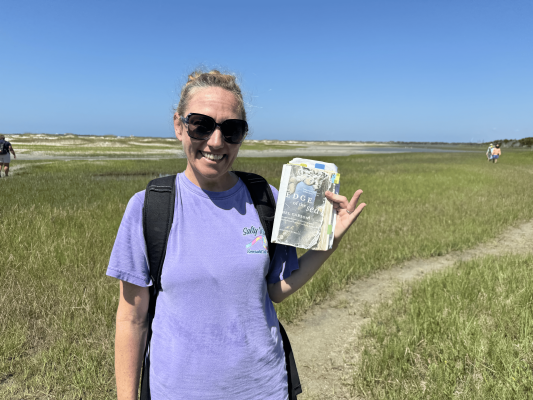Author: Jillian Daly
Playing games? Learning about science? And receiving a stipend for it? That’s what 13 North Carolina teachers got to do for two days in June at the Rachel Carson Reserve in Beaufort, N.C.

Teachers on the Estuary (TOTE) workshops are hosted at each of the 30 reserves in the National Estuarine Research Reserve System. At the N.C. Coastal Reserve & National Estuarine Research Reserve, our education coordinator, Lori Davis, leads the workshop each year.
On the first day of the workshop, we headed straight to the reserve for a field trip. The teachers arrived, sprayed sunscreen, and buckled their life jackets. After a brief boat ride, we explored the water’s edge, just like the Reserve’s namesake, Rachel Carson, once did.
One teacher participant, Shelley C., brought her heavily notated copy of Carson’s Edge of the Sea, which details the sights and sounds that Rachel Carson experienced when visiting this same island in the 1940s. As we walked, Shelly exclaimed over the sight of fiddler crabs that matched Carson’s description, and questioned why the crabs had claws like spoons.

The teachers’ enthusiasm only went up as our shoes got stuck in the mud, the smell of the marsh permeated the air, and pickleweed was snacked on. After a few hours of exploring the reserve’s coastal habitats, we headed back to the classroom to cool off and eat lunch before hearing from local scientists.
Dr. Carol Price stole the show by playing a video demonstrating a baby shark moving in its mother's belly. Dr. Price works for the North Carolina Aquariums as the conservation biologist and gets to work with sand tiger sharks, gopher frogs, and sea turtles. Her presentation captivated our teachers with the stunning photos of sand tiger sharks hanging out at our local shipwrecks, and videos of tadpoles growing arms and legs until they look like their full-grown self!
Two local NOAA scientists, Jessica Branscome and Amanda Rezek, ended the day by showing off the ear bones of fish, called otoliths. Otoliths help age fish similar to how the tree rings can tell you the age of the tree. The teachers oohed and ahhed, and left for the day with smiles on their faces, and ideas for incorporating the science they learned into their classes next year.
Keep reading this blog series: Part 2 & Part 3 (coming soon)

